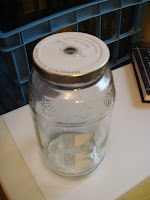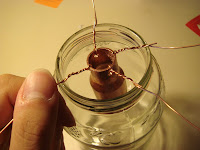The most common way of converting fuel into mechanical energy is... well, light it and set it into a combustion phase. To make this process more efficient, oxygen (air) is mixed with the fuel to burn better. To make this even more efficient, this fuel/air mixture would have to be compressed. Upon ignition, it would create a greater explosion, thus providing more thermal energy to be converted into mechanical energy, leading to the desired end result of thrust. The pulse jet is designed to do every stage... on its own.
Here is the diagram Wikipedia explains this process with.
This is a rather intriguing process, if you are ever lucky enough to observe such a process. Lucky for you, since you're currently reading this post, you shall observe such a process. But with all sarcasm aside, a pulse jet in application can actually be quite dangerous. During World War II, Germany developed the V-1 Flying Bomb, which is equipped with (yes you've guessed it) a pulse jet as its primary source of thrust. Since the jet combustion happen rapidly, sounding off each combustion individually (50 times per second for the V-1), it was dubbed the "buzz bomb."
Obviously, I'm not here to build a bomb (thank you Homeland Security, you can relax now). I am only creating a demonstration of what this pulse jet cycle would look like when it is created from things I found around the house. Now that you (the reader) have been equipped with a brief understanding of pulse jets, let's get to work.
So I started off with a glass jar. Grape jelly/jam jar. Finished it, rinsed it, dried it. Then I proceeded to drill a hole on the center of the cap.


Then I proceeded to drill the mounting holes for the diffuser.


Here is what the diffuser looks like when it's completed and ready to be inserted.


Safety concerns (it should ALWAYS be a primary concern), along with my father threatening to kill me if I accidentally burn down the house, has motivated me to build a blast hole. It isn't much. A polycarbonate (Lexan to be specific) panel, supported by 4 L-brackets and bolts, along with a "blasting chamber" formed from concrete blocks. Overkill? Yes, but I'm sure I'll use this again in the future.
And ALWAYS WEAR SAFETY GOGGLES. Any experiment can be fun but no experiment is worth your vision!!! So if you are doing this, please protect your eyes. I also lit it from a distance (with a birthday candle I rubber-banded to a stick).


Time for my disclaimer: I AM NOT RESPONSIBLE FOR ANYTHING YOU DO IN RESULT OF VIEWING THIS POST.
Thanks, and please don't try this at home. If you absolutely have to try it at home (I know some of you are starting to get the itch), please do it under adult supervision with careful understanding of this material =].
 So the fuel of choice is, HEET, which is a gas-line antifreeze & water remover. I've also heard other recommendations from STP Jet Fuel, to suggestions such as gasoline, or kerosene and all types of fuel. To the best of my knowledge and experience, HEET or STP Jet Fuel would work best. (Please don't experiment with different types of fuel unless you've done a good amount of research on its properties and reactions). I picked up a 12 oz bottle of this at my local autozone for like 2 or 3 bucks. Which isn't much but it feels like 10 bucks in this recession :(. But anyways, all in the name of science, no?
So the fuel of choice is, HEET, which is a gas-line antifreeze & water remover. I've also heard other recommendations from STP Jet Fuel, to suggestions such as gasoline, or kerosene and all types of fuel. To the best of my knowledge and experience, HEET or STP Jet Fuel would work best. (Please don't experiment with different types of fuel unless you've done a good amount of research on its properties and reactions). I picked up a 12 oz bottle of this at my local autozone for like 2 or 3 bucks. Which isn't much but it feels like 10 bucks in this recession :(. But anyways, all in the name of science, no?So before the demonstration, I put the glass jar in my freezer (recommended, based on articles I read) to lower the temperature of the container to prevent cracking. I also placed an aluminum tray on the concrete block, with a bit of water, so part of the jar is submerged slighty (to also keep the temperature down). The aluminum tray also serves as a container that makes it easier in the end if I have to pick up any shattered glass pieces.
Also, prior to lighting, I placed a finger over the exhaust hole and shook the jar somewhat vigorously. This will shake up the liquid fuel and make more gas vapor (for better combustion).
So the first test I conducted with the grape jam jar, I received the following results:
(By the way, I did this in the evening, so it would be easier to see the action)
This is the first test as well as the second test.
Also on a side note, the videos show blue flames from the combustion inside the jar. What is not seen is that jets of hot flames/air is being shot upwards from the exhaust hole on top. This is the thrust that pushes a payload, such as a missile or rocket, in the direction it is going. So in theory, the thrust is actually forcing the jar downwards pushing it harder against the concrete.
The following is the third test and fourth test:
(still the same setup but with a greater attempt at making it work, with slightly higher success)
I learned that this jar is simply too big for simultaneous combustion so I looked around the house and found a smaller jar. There are no pictures for how I made the second jar, but it is exactly the way I did it with the first jar (except I used the same diffuser from the first jar).
This one FINALLY worked! =] (minus the glass shattering in the end)
I fired it up with the same procedures. I finally got the results I wanted, a continuous series of rapid combustion (although the glass cracked in the end when it couldn't handle the heat and pressure anymore).
Here's what it looked like in the end (the next morning):


So I was originally going to stop here.. But I thought, hey there's still one more thing I'd like to try (there's always one more thing..). That led to test 6 (the next day) which was more, uhh, "exciting" than I anticipated...
So that was totally unexpected... I should have been more careful (although honestly, no one would have saw that coming). My disclaimer again: I cannot be held responsible for anything you do after reading this post).
The aftermath... I guess I'll have to sweep up the broken glass tomorrow morning when the sun is up. Don't try to clean this at night, it's more dangerous when you can't see anything!


So there you have it. The pulse jet concept demonstrated in my backyard (minus my mini fire hazard in test 6). Anyways, I hope you've enjoyed this post, and I hope you learn and take a lot from what you've read. Let me know what you think!
Wayne Chen =]
